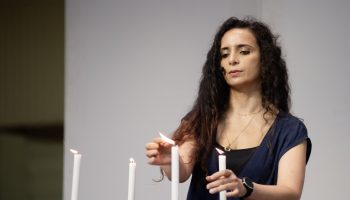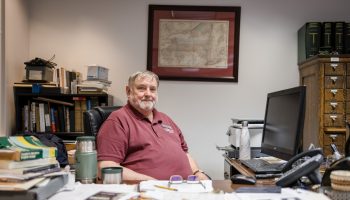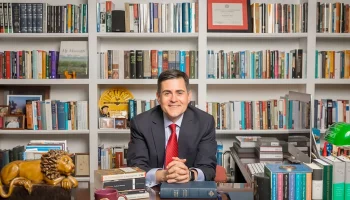
Julia Weber
Staff writer
Arts leader Kate D. Levin delivered the first lecture for “Arts in Action: Building Community Through the Arts,” Chautauqua Lecture Series’ Week Three theme, at 10:45 a.m. Monday in the Amphitheater. Levin oversees the Bloomberg Philanthropies Arts Program and brought her knowledge of community building through the arts to the Amp stage. Having served as the commissioner of the New York City Department of Cultural Affairs from 2002 to 2013, Levin created support for artists and cultural organizations, expanded economic development initiatives in the creative sector and oversaw the city’s commissioning of public art.
During her lecture, Levin discussed current challenges hindering the creative sector and looked at a number of successful initiatives as case studies for supporting public arts and fostering community.
“I think there are some powerful, unacknowledged contradictions here in the U.S. when it comes to culture — especially, but not exclusively, the nonprofit part of the sector — and until we fully grapple with those tensions, the arts won’t reach their full potential in the service of our communities,” Levin said.
She said that while the financial returns of the arts sector are “staggering,” the field often faces a lack of funding compared to fields like science, technology, engineering and math.
Levin also said that through examining a number of case studies of successful pilot projects, she would explain how similar endeavors can build and strengthen communities by addressing community needs.
Levin said a major obstacle in creating comprehensive and effective policy regarding the arts is that the arts are often seen as a secondary priority.
“Too often, the creative sector is talked about and treated as anything but central,” she said. “Instead, it’s seen as ancillary, ornamental, or the ultimate insult in policy conversations: Nice but not necessary.”
Levin explained part of the problem with gauging metrics of success in art comes from the inability to quantify it. Because audiences expect art to address needs, confront issues, provoke thought and simultaneously provide solace, comfort, stimulation, entertainment, education or inspiration — all subjective emotions that vary from viewer to viewer — it can be difficult to accurately measure its success in any one specific way.
“I’m positing that we tend to bring heightened individual expectations to our experience of culture, even if we experience it in the company of others,” she said. “With most other sectors, we want excellence to be standardized — visibly so — and universal as a sign of respect and fairness.”
Levin used the example of trash collecting as excellence; its excellence lies in a fair and equal service to all, rather than a case in which it excels in one area over another.
“With culture, we often think of its impact precisely to the degree that it doesn’t seem standard, that it does feel personally transformative,” she said.
Levin also said the public’s perception of artists often does not align with the reality of artists’ living situations. The myth of artistic genius has led to a misperception of artists, and Levin said many individuals may make art while not considering themselves to be artists because of the incorrect perceptions about them. This misperception has political implications as Congress prioritizes other, more tangible workforces over the creative sector, which Levin explained as a logical extension of the problematic mentality of rarefying artists because “lightning strikes of charismatic inspiration don’t add up to a workforce of real people.”
As an example of the public’s “skewed national perspective” about artists, Levin pointed out U.S. tax code laws, which allow patrons to claim a tax write-off of a donated artwork for its full appraised value, but they only allows artists to claim a tax write-off for the cost of the materials used and not for an artwork’s full, appraised value.
“That’s (the) market value of a work created by an artist solely through their skill, imagination and labor,” she said.
Levin recalled an experience working for the New York Department of Cultural Affairs in which she was puzzled by how few residents identified as artists in U.S. census data. Upon further realization, she concluded that individuals only made this identification if it was how they made a living, which excludes many artists who hold other jobs in addition to their art practices. She called this a “fascinating form of humility in the face of capitalism’s correlating income and occupation.”
Levin described a thought experiment in which, when participants were asked who played golf, many raised their hands and, as a follow-up question, who considered themselves to be a golfer, many continued to raise their hands. But conversely, when the same question was asked about playing piano versus identifying as a pianist, there was a considerably larger gap between the skill and the identity.
“Excellence in the arts is too often now seen as elite and exclusive rather than on a continuum with room for everyone,” Levin said.
“The distinction between amateur and professional in the arts was nurtured with the best of intentions, to cultivate talent and consolidate the sector’s value and visibility, but instead, we have somehow internalized that distinction between amateur and professional in a way that has severed the inclusion and welcome so essential to a thriving sense of culture’s place in building community.”
Levin acknowledged the arts sector’s predisposition to categorizing disciplines and art periods when, in reality, artists often work across disciplines, movements and genres quite frequently. She cautioned against this “tendency to force hierarchical distinctions between categories and cultural expression.”
“Culture is unpredictable, but it’s dependable,” she said. “You can’t predict content, you can’t know in advance what an artwork or performance or exhibition will look or feel like, even when it’s a revival of a classic, but you can be pretty confident that whether the work is praised or panned, it will contribute something productive to human dynamism and community because that’s what culture has done dependably for millennia now in the West.”
In the second half of her lecture, Levin outlined a number of initiatives she has seen to be effective throughout her career in bolstering the arts sector through public participation and civic dialogues.
One public artwork, “The Gates, Central Park, New York City, 1979–2005” by Christo and Jeanne-Claude, had a huge impact both on tourism and the economy, but it also brought a more unique value to the city.
“What we couldn’t count was the value to New York, only a few years after 9/11, of being featured in every kind of media around the world — not for war, or death or money, but for imagination, ingenuity and saying ‘Yes’ to colossal creativity by two immigrant artists who are passionately committed to their chosen home,” Levin said.
Levin also described a handful of other case studies including a collaboration with transportation officials to create street paintings to reduce traffic accidents.
According to Levin, these projects delivered both quantitative and qualitative improvements, but they also brought local artists to the status of essential community partners rather than relegating them to the misperceptions Levin highlighted earlier in her lecture.
“Their skill at communicating across many different types of stakeholders and of listening to, involving and celebrating their neighbors is often a local revelation and always a positive lesson learned about the value of artists as community builders,” she said.
She reviewed a number of recent grants supporting local communities in their ability to address prevalent issues through many different forms of art. These issues spanned pressing topics such as food insecurity, public health and climate change, all addressed through different art mediums by community members.
“None of the projects I’ve described are polemics. Rather, they reflect and refract creative interpretation to generate curiosity, serve beauty and build public will around each city’s identity, economy and quality of life,” she said.
To close her lecture, Levin spoke about the importance of recontextualizing the role of the arts in order to better understand it as a field.
“No one votes based on the arts,” she said. “Instead, they vote based on things like the economy or crime, but if you ask people what they love most about the places they live — especially if they live in cities — the answer is always related to culture: the local museum or the park or theater, the bookstore or jazz club down the street, the food scene or festivals that make people feel rooted, energized, inspired.”
“To properly position artists as community builders, which so many of them so manifestly are, we need to move past the contorted view of creativity that currently prevails,” she said. “The slippage between perception and reality is a challenge, but it’s also an opportunity because the things we love most about our communities are the things we build through the arts.”




